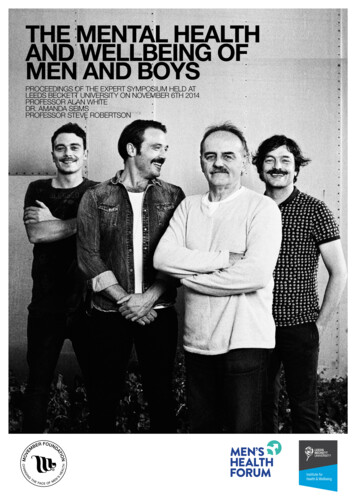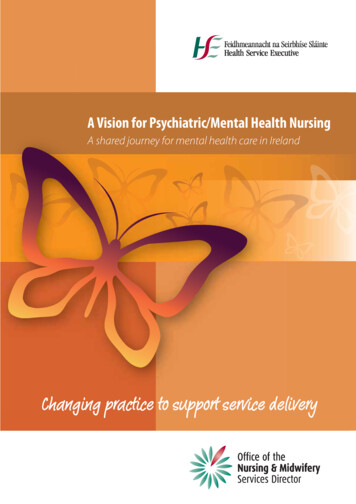
Transcription
The mental healthand wellbeing ofmen and boysProceedings of the expert symposium held atLeeds Beckett University on November 6th 2014Professor Alan WhiteDr. Amanda SeimsProfessor Steve Robertson
The Movember Foundation is aglobal charity raising funds andawareness for men’s health.Across 21 countries, the Foundationis committed to driving awarenessand strategically investing in men’shealth programs so men can livehappier, healthier and longer lives.Since starting out in Australia back in2003, the Foundation has raised over 346 Million, with funds being directedto programs addressing prostatecancer, testicular cancer and mentalhealth problems.Working year round, the Foundation’svision is to have an everlasting impacton the state of men’s health, which willbe achieved by continuing to fight foras long as men’s health issues exist.
Report compiled byProfessor Alan WhiteDr. Amanda SeimsProfessor Steve RobertsonCentre for Men’s Health, Leeds Beckett UniversityWe thank the presenters for checking their summarieswithin the report. We would also like to acknowledge thecontribution of all those who took part in the event.To reference this article please use the following citation:White, A., Seims, A. and Robertson, S. (2015) Proceedingsof an expert symposium on the mental health andwellbeing of men and boys, November 6th, 2014, Leeds.London, UK : The Movember Foundation in associationwith Leeds Beckett University and the Men’s Health Forum.ISBN 978-1-907240-40-93 The mental health and wellbeing of boys and menThe Movember Foundation
Executive SummaryAs societies become increasingly complex, moreand more men are finding they are experiencingmental health difficulties. Suicide rates in menare increasing, and those being diagnosed withdepression and anxiety are on the rise. There is alsothe realisation that a significant number of men whoare struggling with their mental wellbeing remainhidden from services and are not being adequatelysupported or reached with current mentalhealth provision.In March 2014, the Movember Foundation Boardapproved, in principal, the development of the ‘TakingAction on Health and Wellbeing’ Programme for the UK,which is to introduce a Mental Health component totheir existing work on prostate cancer. In preparation forthis work, the Centre for Men’s Health at Leeds BeckettUniversity, in collaboration with the Men’s Health Forum,was commissioned to undertake a literature review andenvironmental scan of the sector within the UK. As part ofthis programme of work, an Expert Symposium was heldwith over 40 individuals and organisational experts in seniorpositions who have involvement of working with boys andmen around mental health issues in the UK, along withmen who have mental health problems.The aim of the symposium was to tap into the tacitknowledge of those working in academia, the thirdsector and in statutory organisations involved in policyand practice in order to inform our understanding of thelandscape of mental health work in the UK. The focusof the discussions within the symposium was intendedto generate ideas and suggestions about how futureinterventions and policy could be best implemented toimprove the mental health of men and boys.The morning session comprised presentations from keyindividuals from the different sectors to present their viewson what is known, what is not known and what is neededto see men’s mental health provision improve in the UK.There were also presentations from two men from Voicesof Mind to ensure the user’s perspective was central to allthe discussions.4 The mental health and wellbeing of boys and menThe key themes identified through the afternoon groupdiscussion were:1.Initiatives/services need to be responsive tomen’s needs2.Appealing environments and safe spaces for menexperiencing problems should be created3. Peer support and self-help should be available forthose in need4.Acknowledgement that mental health is affected byphysical health and social issues5. Society and culture needs to change to improvegender equality6. Intervention and education must be incorporated intoearly years and provided regularly throughout life,particularly during key transition periods.7.Vulnerable groups need to be targeted8. The importance of leadership figures and the state tofacilitate change9.Specific training needs to be undertaken with all thosewho come in contact with vulnerable men10. Research needs to focused onto the problem of men’smental healthThere was also a recognition that the time was right fora stronger political push to engage more with the issuesraised by men’s mental health and that a Declaration onMen’s Mental Health and Wellbeing needed to be created.The Movember Foundation
ContentsBackground to the Symposium06Introduction to the day’s proceedings07Presentation 1 - The Movember Foundation08Presentation 2 - Perspective of a service user10Presentation 3 - Emerging findings from Movember literature review and environmental scan12Presentation 4 - Perspective of a policy maker14Presentation 5 - Perspective of an academic and psychotherapist16Presentation 6 - Perspective of a Third Sector service provider19Presentation 7 - Perspective of a service user22Afternoon group discussion and feedback24Key themes emerging from the day’s discussion25Summary of the day and suggested future action points30Appendix 1: Symposium attendees31Appendix 2: Programme for the expert Symposium325 The mental health and wellbeing of boys and menThe Movember Foundation
Background to the symposiumDay-to-day knowledge about what works inreaching out to men and boys with regards to theirmental and emotional health exists at many levels ofservice provision. The aim of the symposium was totap into this tacit knowledge of health experts fromacademia, third sector and statutory organisationsinvolved in policy and practice in order to inform theoverall environmental scan being undertaken for theMovember Foundation.This event was also seen as an important opportunityfor significant organisations to hear about the work beingundertaken, with a view to becoming possible step twoand three partners who may collaborate in the ‘TakingAction on Health and Wellbeing’ programme in the pilotstage or beyond. In addition, the event provided a platformfor commencing aspects of knowledge disseminationfrom the earlier work packages into organisations thatmay have influence or may likely be adopters of thelearning generated.We invited over 60 people from key statutory and thirdsector/NGO organisations to the symposium who hadbeen identified through discussion within the project team,the wider network, and in consultation with the MovemberFoundation (a list of those who attended the symposiumcan be found in appendix 1).The day was structured (see appendix 2 for the schedule)to give a morning of presentations aimed at informingattendees of the key findings of the current study(Professor Steve Robertson), an overview of the academicbase to boys’ and men’s mental health (Professor DamienRidge), the perspective of the Third Sector (Paul Farmer,CEO MIND) and a policy perspective (Gregor Henderson,Public Health England Mental Health Lead). In addition,there were two user perspectives from the Voices of MINDteam, one (James Downs) representing a young man’sperspective and the other an older man (David Hill).The focus of the discussions within the symposium wasintended to generate ideas and suggestions about howfuture interventions and policy could be best implementedto improve the mental health of men and boys. Theworking objectives for the day were: to provide space to undertake some ‘blue-sky’ thinkingon what could be achieved if resources allowed. to hone expectations based on current experience fromthose in the room as to what is actually achievable. to generate a consensus on priorities for what should betackled as we move forward. to facilitate discussion on the respective roles of policy,practice, voluntary organisations and the Third Sectorin meeting these priorities – i.e. what is needed to makethis happen?6 The mental health and wellbeing of boys and menThe Movember Foundation
INTRODUCTION TO THEDAY’S PROCEEDINGSProfessor Alan WhiteCentre for Men’s Health, Institute for Health & Wellbeing,Leeds Beckett University (pictured below)Gregor HendersonNational Lead for Wellbeing and Mental Health,Public Health EnglandAlan welcomed the organising partners, theMovember Foundation and the Men’s Health Forum,and the delegates, which included policy makers,practitioners, senior members of third sectororganisations and service users. Alan stressedthe importance of considering issues from theviewpoint of service users throughout the day. Alanexplained that the purpose of the day was to providean opportunity for experts with a wide range ofknowledge and experience to get together for someblue-sky thinking, focusing on issues relating tomen’s mental health and identifying how we will takerealistic ideas forward.There is an abundance of evidence and literature whichhighlights issues relating to men’s mental health anddocuments successful services and strategies; however,it is important that we also consider evidence that goesbeyond traditional randomised controlled trials. Despitethe wealth of available evidence, the task of implementingchanges which may improve men’s mental health isdifficult. Furthermore, we face the challenge of trying topersuade local government to implement initiatives andservices which address men’s mental health in the face ofextreme budget cuts.The knowledge gathered through the day would contributetowards the overall work of the Movember Foundationand the current Environmental Scan being undertaken byLeeds Beckett University for the Movember Foundation,and to provide useful information for the whole sector ofmen’s mental health.Gregor stressed that mental health, particularly relating tomen, doesn’t get sufficient attention. Gregor highlightedtwo main challenges faced by those working in mentalhealth: 1) should we place our focus on dealing with mentalillness or promoting mental health, or are both equallyimportant? 2) should we create separate specific servicesthat focus on mental health for men or should we embedthe importance of mental health into how we approachmen’s lives and their health and wellbeing; to do this weneed to challenge the current culture where mental healthisn’t routinely considered alongside traditional indices ofhealth for men. We need to consider how we can createa collaborative strategic leadership across the UK toachieve this.7 The mental health and wellbeing of boys and menGregor suggested that we need to take a balancedapproach to promotion, prevention, care and treatment,and invest in prevention and health improvement alongsideservices. This requires balanced investment in downstreamservices as well as investing in upstream preventativemeasures, but to do this we need to be able to measurethe cost of this investment vs. the savings from possiblypreventing mental health problems.Gregor requested that the delegates engaged in the daywith the aim of considering how leadership could becoordinated following the event to initiate change andconsider strategies to implement the wealth of scientificand practical evidence that is currently available.The Movember Foundation
Presentation 1Sarah CoghlanUK Country Director,The Movember FoundationSarah began by sharing the storyof how the concept of Movemberbegan. In 2003, two friends noticedthat moustaches were one of thefew things that hadn’t come backinto fashion and subsequentlychallenged each other and 30friends to grow a moustache over30 days. After receiving significantattention from passers-by, theydecided to do it again in 2004 butwith a more formal concept raising money for prostate cancer.They set up a company, approached the chairman of theProstate Cancer Foundation of Australia and said they’dget men to grow moustaches to fundraise for them. In thefirst year they raised 54,000 and in 2006 they became theMovember Foundation, adding mental health as a cause.Since then, they have raised a total of 346 million aroundthe world to support men’s health programmes andservices. In 2008, they set up four global offices, includingthe UK, and 2014 is the first year to invest in men’s mentalhealth in the UK.Mental health investmentThe focus of their investment in mental health is onprevention, early intervention and stigma reduction. Sarahstressed that small pockets of work show that men willinteract if given an appropriate setting. The MovemberFoundation is aiming to identify why men engage withthese activities when they won’t engage with local authorityservices or health care. They appreciate that men actdifferently to women with regards to their health: men likedoing things and prefer to talk shoulder to shoulder, notface to face.The Movember Foundation believes that engaging menin mental health services may have an impact upon theirengagement with other services, such as screeningfor physical diseases, physical activity programmes orsmoking cessation clinics which may ultimately reduceprevalence of physical diseases.8 The mental health and wellbeing of boys and menThe Movember Foundation
Sarah CoghlanUK Country Director,The Movember Foundation9 The mental health and wellbeing of boys and menThe Movember Foundation
Presentation 2Perspective of a service userJames DownsVoice of MindJames initially suffered withobsessive-compulsive disorder(OCD) which resulted in issuessurrounding the control of foodand the development of anorexiaand bulimia, significantly impactingupon his life. James (aged 25), havingsuffered from severe mentalhealth problems for the past 10years, provided the audience witha younger person’s perspectiveof someone who has had toengage in services, and conveyedthe difficulties he experiencedin seeking help and engagingwith services.Negative experiences of help seekingJames’ initial experience of mental health services wasthat they questioned why he had an eating disorderinstead of simply recognising the problem. He felt that hisproblems were not always validated, which led to denialand self blame.James’ eating disorders often caused health problemsresulting in hospitalisation, where he felt that the physicalsymptoms were treated and dietary advice was given toavoid reoccurrence of the health problem, but there was noconsideration of the underlying psychological issues whichwere causing his hospital admittances. James felt thatdoctors tended to try to get him to rationalise the problemand trivialised it instead of accepting he needed therapy.10 The mental health and wellbeing of boys and menThese negative experiences almost caused James asmuch anxiety as dealing with the problem itself, and hestressed that negative interactions with services can oftenmake a problem feel worse and may cause men to ceasefuture engagement. As a result of these experiences, ittook six years for James to receive psychological therapy,and later behavioural therapy, as his issues with controllingfood had progressed into a severely entrenched problem.He felt that therapies such as mindfulness, with littleevidence base compared to more traditional therapies,should not be quickly dismissed by health professionals.The best evidence is the patient, and unless non-traditionalforms of treatment are explored and trialled, then a soundevidence base may never develop.Gender stereotypesJames’ OCD led to him missing a lot of the school year,partly due to the issue being dismissed as a typical boy’sbad behaviour. He feels that women are traditionally treatedas more fragile and emotional, whereas the emotional painexperienced by men is often not acknowledged. Educationis needed to reduce stigma and validate men’s issues,accepting that men may experience emotional difficultiesas much as women.He acknowledged that there is no typical experience fora young man and no uniform set of characteristics; theynow face many of same pressures once associated onlywith women, such as objectification of their bodies, aswell as receiving conflicting messages of male sexuality.The prevailing ‘lad culture’ reinforces that male emotionis shameful and weak and disallows sincerity of men’sfeelings. In the modern day there is a breakdown of genderroles and it is not appropriate to associate personality traitsor disorders as male or female.James felt that his experience of services supportingeating disorders were tailored towards women’s needs andexperiences, and found himself in an endless pursuit ofdiagnosis which ‘fits’ a man, as they were unable to acceptthat men suffer from eating disorders. Services need toabandon these outdated stereotypes and acknowledgethat there is a person behind the symptoms and that men’ssymptoms are as real as women’s.The Movember Foundation
James DownsVoice of Mind11 The mental health and wellbeing of boys and menThe Movember Foundation
Presentation 3Emerging findings from Movember literaturereview and environmental scanProfessor Steve RobertsonCentre for Men’s Health,Institute for Health & Wellbeing,Leeds Beckett UniversitySteve presented early findingsfrom the work Leeds BeckettUniversity has recently conductedfor the Movember Foundationwhich focused on upstream mentalhealth promotion to establish whatworks in relation to men and boy’smental health, in what context andwhy. The work primarily evaluatedevidence from an extensive reviewof literature and tacit knowledgefrom 15 selected projectssourced through databases ofexisting projects and through aninvestigative network of 15 peopleacross five countries. Furtherwork will be completed followinga thorough analysis of thisevidence; presented here are verypreliminary findings.Settings-based interventionsWhereas interventions based in schools had variedsuccess, limited evidence suggested that single sexinterventions are more successful for boys and girls.Work-based cognitive behavioural therapy (CBT) reducedstress and depression, and internet-based CBT seemedas effective as face to face interventions. However, someevidence suggested that participation and completionof general online interventions is lower in men comparedto women.Interactive/activity-based interventionsInitial evaluations observed consistent short-term mentalhealth benefits, such as improved self-esteem and mood,from engagement with nature and green space. Exerciseand sport-based settings showed positive effects onsymptoms of depression and anxiety, and may be moreeffective when single sex. Social group-based activity,particularly in a male-specific place, also showed promise.SuicideThe evidence suggested that multi-dimension interventionsmay be more effective in reducing stigma, influencingattitude and changing behaviour, than single dimensioninterventions, such as campaigns to raise awareness;however, they must be tailored to account for culturaldifferences. Arm’s length support, or using typical malesettings such as sports clubs and the workplace, alsoappear to be effective for men.Using a male-friendly/sensitive approachThe environment where interventions are based needsto be appealing or familiar and somewhere they canfeel comfortable and at ease, whilst also accounting forethnicity, age and sexuality. The use of direct mental healthlanguage may not appeal to some men; however, completeavoidance may reinforce stigma and deter men from feelingcomfortable opening up to others. Sub-group specificaction, social engagement interventions and talking in safeplaces (e.g. sharing stories or interacting online) may alsoappeal to men.Values and ethosInterventions may be more effective if staff have livedexperience of the issues, can empathise and are ofthe same culture/sexuality. It helps if programmes areresponsive to the needs of the person and communitiesthey serve, rather than just following funding guidelines.The intervention should also enable environmental andlifestyle changes to facilitate general behaviour change,for example directing men to other support services toaddress housing or employment concerns.An open forum discussion with the Symposium attendeesrecognised that work-based settings are good formotivating staff and make employers appear to be a caringorganisation; however, isolated men such as retireesor the unemployed are not in the workplace so will notbenefit from these interventions, therefore Men’s Shedsmay be more effective for these people. For communitybased settings it was stressed that users must be givenownership to shape the nature of the activities provided.It was suggested that key transition periods in men’s liveswhere mental health may be at risk should be identified,e.g. becoming a father or retiring, as men are evaluatingtheir identity during these times.Project staff and those who interact with the public, suchas the police, must be given training on mental healthissues and be able to direct those in need to the mostappropriate support.12 The mental health and wellbeing of boys and menThe Movember Foundation
Professor Steve RobertsonCentre for Men’s Health,Institute for Health & Wellbeing,Leeds Beckett University13 The mental health and wellbeing of boys and menThe Movember Foundation
Presentation 4Perspective of a policy makerGregor HendersonNational Lead for Wellbeing and Mental Health,Public Health EnglandGregor noted that highlightingsignificant health issues in thegeneral population can oftenresult in discussions relating toinvesting more money into the NHS.Increased funding of the NHS isdifficult however, given the limitedfinancial resources available.Investment in upstream preventativestrategiesGregor suggested that the underlying solution needs toshift our thinking to include preventative strategies and thatwe should consider integrating mental health support intoother services as well as having focused services.We also need to shift focus to changing the underlyingpsychosocial and socioeconomic causes. As an example,one of our biggest health problems which is a significantfinancial strain on the NHS is obesity. The usual treatmentis referral to weight management services incorporatingexercise and dietary interventions; however, a moreeffective strategy may be to identify possible mental healthissues causing overeating and sedentary behaviour, suchas low self-esteem or depression.He noted that one area for an upstream strategy was toprovide courses for emotional literacy, mindfulness andcognitive behavioural therapy where potential mental healthrisks are initially identified. One strategy which requireslittle to no investment at all is a change of culture within oursociety, which allows men to express emotions and speakout confidently about mental health without stigma.14 The mental health and wellbeing of boys and menIntegration of mental health supportwithin other servicesOne reoccurring suggestion was to invest money into theeducation and training of leaders and those in positions ofauthority or providing front line support such as politicians,senior managers, teachers and police constables andthose making policies. There is a developing cohort ofmental health champions based in local authorities. GPs,local mental health support teams and buddies withinthe community could be trained to spot men at risk ofdeveloping severe mental health problems, particularly inolder men as they may not actively speak out about mentalhealth unless there are associated physical symptoms.Leadership of local mental health strategies shouldnot be solely allocated to mental health professionals,it should be led collaboratively and include non-healthrelated areas, such as housing and employment, as theycan provide leadership on how these services couldintegrate mental health support. Interventions used inScotland that integrated mental health into the criminaljustice system, education and employment services haveshown successful outcomes, but strategies like thesewill only work if we change the design and delivery ofpublic services outside of health and care services. PublicHealth England and local government can help provideleadership to ensure that service commissioners andprofessionals involved in policy making consider gender intheir decisions.Gregor highlighted that although these suggestions showgreat potential, they are difficult to implement unlesswe can demonstrate a clear cost and benefit to thoseproviding financial investment. So investment in researchand evidence is crucial.The Movember Foundation
Gregor HendersonNational Lead for Wellbeing and Mental Health,Public Health England15 The mental health and wellbeing of boys and menThe Movember Foundation
Presentation 5Perspective of an academicand psychotherapistProfessor Damien RidgeHealth Studies, Westminster UniversityDamien provided an overview ofsome of the challenges facedby men when seeking help fordistress, and for service providerstrying to engage with such men.We know that mental healthproblems in men may not bediscovered, as they may expresssymptoms differently comparedto women; they may be strugglingwith life and not realise it is relatedto mental health problems; theymay be blocking emotions; or actingthem out (e.g. becoming violentor abusing alcohol and drugs).Although gender differences arebecoming less distinct, women arestill likely to be more in touchwith their emotions, and receive adiagnosis of anxiety or depressioncompared to men. Men are lesslikely to receive help for mentalhealth, which is reflected in thealarming statistic that four out offive suicides are by men.Men are typically emotionally isolated; many are lonely,and lack the social and emotional support that womencan turn to. However, they yearn for emotional connection,and because they have locked away their emotions, theycan actually be hypersensitive behind their manly facade.They fear expressing their vulnerabilities and may feelreluctant to speak to a doctor. Whilst services struggleto reach out and engage with men, some professionalsmay be reluctant to engage with distressed men as it isuncomfortable e.g. it challenges their own socialisationthat men should be strong. Men are keen to talk, however,when they feel it is safe to do so. It is common for talkingtherapists to be the only person a man has disclosed theirtrue feelings to.It is important to realise that men do want help, but maysimply struggle finding it. They may feel discouragedfrom getting help if their partner/friends mock them forexpressing emotions. However, ironically, getting helpmeans regaining strength, a sense of masculinity andgetting back on their feet. Damien referred to a male clientwho initially had a negative and hostile attitude towardscounselling, but subsequently experienced it as a practical,powerful and useful therapy which helped him understandhis emotions. We need to develop on-going talkingrelationships with men and reduce the epidemic of socialand emotional isolation amongst men.Overview and outcome of a mentalwellbeing interventionDamien referred to a successful intervention project beingrun at the Victoria Medical Centre in London which dealtwith distressed men with everyday life issues (Atlas).The project offered a person-centred therapy and aholistic approach, which included talking therapy andacupuncture, with the aim of preventing further mentalhealth issues in these men.Men were recruited through the use of a poster at amedical centre which explicitly did not include referenceto mental health vocabulary, and instead talked of stressand everyday problems. The poster encouraged partnersto refer men to the project too. They also co-designed theprogramme with GPs to spot and refer potential mentalhealth issues into the project (e.g. men with gastrointestinalissues which were stress related). The offer of a male onlyservice provided validation of men’s emotional needs inthe clinic, and gave the message it was normal for mento talk to someone about their issues. The results of theevaluation will be available before mid-2015.16 The mental health and wellbeing of boys and menThe Movember Foundation
Presentation 5Perspective of an academicand psychotherapistProfessor Damien RidgeHealth Studies, Westminster UniversityThe project used male-friendly practitioners and providedup to 12 sessions, plus an additional six if requested, whichwere offered out of typical working hours to allow all mento attend. Men typically contacted the project becausethey’d hit rock bottom, they simply recognised that theyhad no-one to talk to about their feelings, or their partnerhad encouraged them to engage.The men preferred counselling, but often wanted morethan the initial 12 sessions and some wanted or neededhelp over a longer term. Damien stressed that therisk of short-term provision is that it may not providesufficient time to build a relationship and identify theissues underlying the problem. Additionally, the risk is inidentifying the big problem causing problems, but havingno opportunity to help resolve their mental health issues,leaving the men high and dry and without support. Skilledpractitioners are left having to focus on issues that can beaddressed in short time frames, leaving the larger issuesaffecting men unexplored.The men stated that the relationship with practitionerwas important, akin to mentoring or even paternalistic/maternalistic. After counselling they reported improvedunderstanding and coping, and it is anticipated that thefinal results of the project will also show reduced anxiousmood and perceived stress, positive wellbeing and animprovement in the issue men originally presented with.The project will also examine whether or not there arecost savings before/after treatment in Altas, in terms ofwork absences, unemployment, and use of health/socialservices as an outcome of providing timely and skilledtreatment to show the wider impact of the project andneed for policy change.17 The mental health and wellbeing of boys a
awareness for men’s healTh. Across 21 countries, the Found Ation is committed to driving A wAreness And strAtegicAlly investing in men’s heAlth progrAms so men cAn live hAppier, heAlthier











